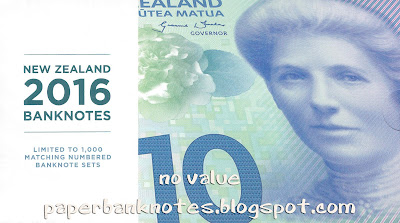 |
| ND2015 |
 |
| Reverse |
 |
| ND2015 |
 |
| Reverse |
 |
| ND2016 |
 |
| Reverse |
 |
| ND2016 |
 |
| Reverse |
 |
| ND2016 |
 |
| Reverse |
 |
| Front Cover |
A full folder set of the New Zealand new Series 7 of banknotes (Brighter Money), first issued in 2015 ($5 and $10 only) and in 2016 ($20, $50 and $100). This is the first upgrade or redesign of banknotes in New Zealand since May 1999 when Polymer notes were first introduced. Like all previous annual set issues, a total of 1000 sets were offered to collectors with serial numbers ranging from 000002 to 001001, all with matching serial numbers. Unfortunately, for this issue, not all prefixes are the same. The $5 and $10 both have the prefix of AA15 (as its first release in 2015) and the remaining 3 notes all have the prefix of AA16 (ND2016). The three notes of $20, $50 and $100 were introduced into circulation on 13.05.2016. These full sets of banknotes are sold as numismatic products to collectors at a premium. The central bank has released full sets of banknotes to collectors since 1999 but not on an annual basis. The last offer was in 2008 (none for 2005 and 2006). Of all the annual issues, the 2000 Millennium sets were the most popular. Unlike the previous issues, these new notes are all printed in Canada, and it retains the Year Date prefix format. Whilst counterfeit of currency in New Zealand is very low, these upgrades are to keep ahead of technology advances since 1999.
$5 - AA15 000098
$10 - AA15 000098
$20 - AA16 000098
$50 - AA16 000098
$100 - AA16 000098
Footnote:
In general, and in many countries around the world, a total set of 1000 is generally considered a low issue to share among collectors. In many countries, such a low issue would have sold out within minutes of its announcement. However the last two issues, 2007 and 2008 sets took a few years before it was all sold out. Was it because there was nothing new to the designs or just lack of interest among collectors? Even to the locals, 1000 sets is not considered a lot to offer, especially when we are talking about matching numbered sets. Will this new series be the same again, or perhaps this is no longer the case? Australia in the 90s did the same as well with similar quantities and it was not that popular, as some were re-sold on secondary markets lower than the official issued price. Time will tell if this has changed.
Sales
Early April 2016 - opened for sale
20.04.2016 - about 60% sold
26.04.2016 - all sold out
This is the first time since 1999 that New Zealand annual sets sold out in less than a month!!
Below are the details of New Zealand 6th and 7th series annual Collector's sets issued from 1999 to 2016 by the Reserve Bank of New Zealand. These are all polymer series of banknotes and only issued for 9 years. Whilst these are numismatic products, not all notes sold in this format were
released to the public for normal circulation. The only way to get the banknote with the particular year is to get the annual collector's sets. All annual sets were limited to 1000 sets only. The first set was issued in 1999 when New Zealand fully converted all banknotes from paper to polymer substrate materials.
1999 - 1000 sets limited edition, only 746 sets sold at NZ$240 per set;
2000 - 1000 sets limited edition, only 817 sets sold at NZ$255 per set;
2001 - 1000 sets limited edition, only 491 sets sold at NZ$250 per set;
2002 - 1000 sets limited edition, only 291 sets sold at NZ$270 per set;
2003 - 1000 sets limited edition, only 273 sets sold at NZ$270 per set;
2004 - 1000* sets limited edition, all sold out at NZ$295 per set;
2007 - 1000* sets limited edition, all sold out at NZ$295 per set;
2008 - 1000* sets limited edition, all sold out at NZ$295 per set; and
2016 - 1000 sets limited edition 7th series, all sold out at record time at NZ$295 per set.
It is not sure why the sale figures for the 2002 and 2003 sets were so low. Perhaps collectors felt that these were only issued as numismatic products and would not bother to keep buying them for all other years. Or could it be that this was due to poor marketing outside the country or the lack of it. However, the distribution method changed for the sale of the 2004 annual sets and from there onward, all sets were fully sold. It is very unfortunate that all unsold sets from 1999 to 2003 were destroyed by the bank. I am pretty sure that all sets with serial numbers from single digit, right up to no. 100 are all in the collector's hand.
Note * - only 999 sets were put on sale as the Reserve Bank retained one set for their own archive purpose.

No comments:
Post a Comment